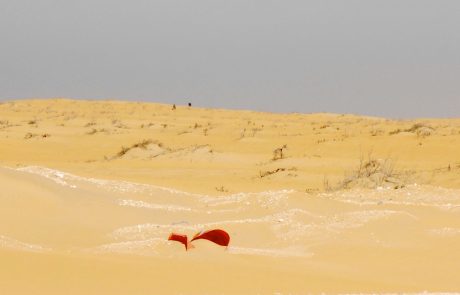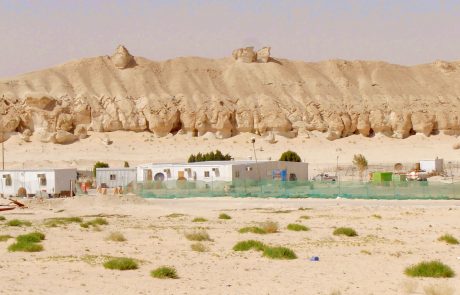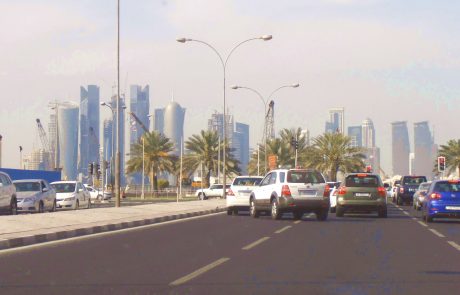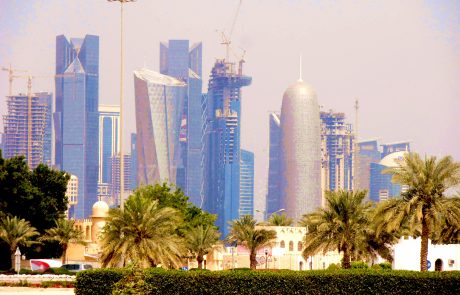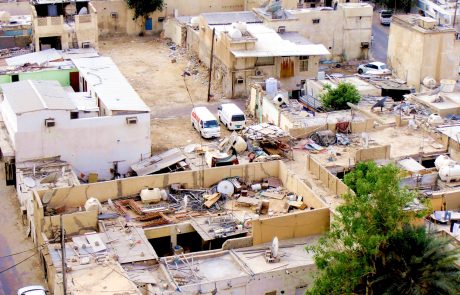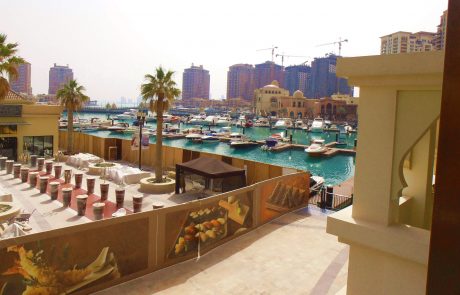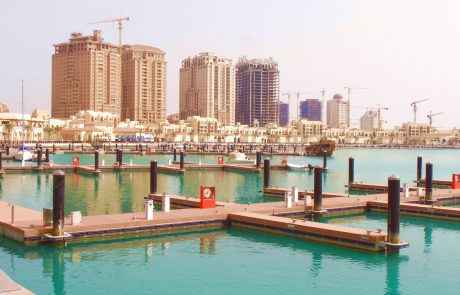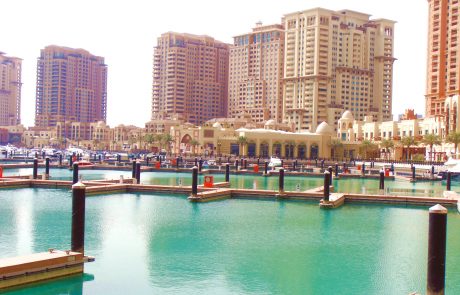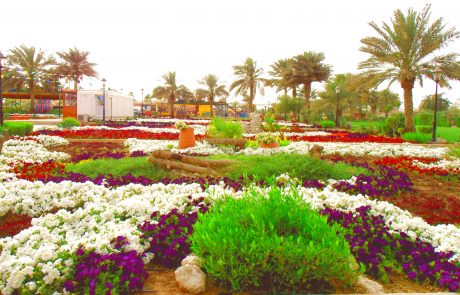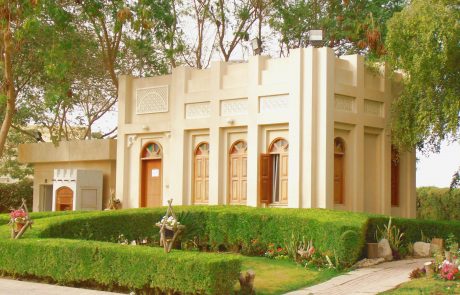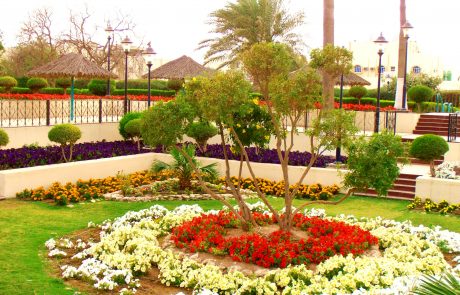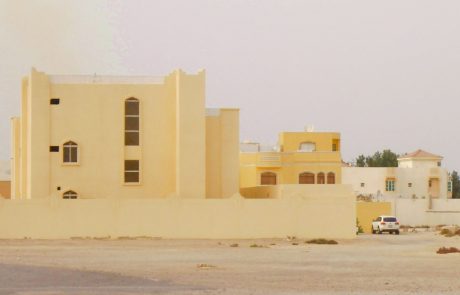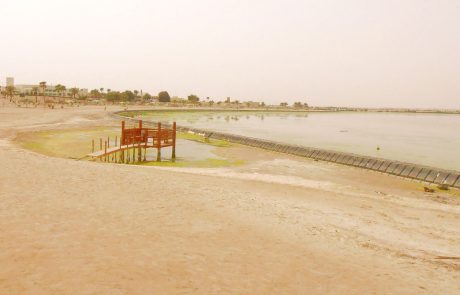September 2018
Qatar is in a spot of bother these days since the severing last year of diplomatic ties and blockades imposed by Saudi Arabia, Bahrain, the United Arab Emirates and Egypt. Al-Jazeera published an article last June (here) about the situation a year on, which suggests that Qatar has powered through the difficulty only slightly worse for the wear. Other news reports that Qatar has found important partners like the United States and China to bolster its position despite the hostility of its closest neighbors. It certainly has enviable resources at its disposal that can’t be blockaded, such as the third largest natural gas reserves in the world. Given that natural resource base, it’s perhaps less than astonishing that the country should soldier on, nothing daunted.
The Qatar I visited during my sojourn in the Gulf area was still an integral part of the GCC and traffic between Saudi Arabia and Doha was brisk. From where I lived in Dhahran it was about five hours by car, a drive straight south across the Eastern Desert to the border and then about 45 minutes into Doha. I remember the first trip very well because the experience of the desert was relatively new to me. I let the textures sink into my eyes, remembering all the while that people live in that place, which seemed impossible. I’d never been in an environment that promised such meagre means for livelihood. Habitation does occur, however, as unlikely (or ill-advised) as it seems. It obviously requires a set of life skills about which I know nothing, nothing at all.
Once you arrive at the border with Qatar, things change dramatically. The road becomes a brand new divided highway with big, beautiful exit signs, as if you’ve just driven into Arizona after a particularly good tax year. It’s all still desert, but this is tamed desert, desert rendered picturesque by the hand of man who has stamped human presence over the entire landscape. It’s all very well to look out over an expanse of barren sand when you know that half an hour away on a highway that would make most metropolitan areas in the United States green with envy there awaits a host of restaurants offering cuisines from around the world. In the back of your mind no thought niggles that if you have flat tire or a breakdown you’ll be lucky to find yourself dining off dried camel’s milk, that Bedouin delicacy the high repute of which, in my humble opinion, tends to be grossly exaggerated.
The bling skyline is not what you see when first entering Doha, however. You start with the outskirts, the suburbs if you will, before you get to the bling. Finally, after wending your way through construction and detours, you arrive at the downtown area and pow, there it is, the look-at-me-I’m-so-cool skyline. If you’re an up and coming city in the Gulf you absolutely must have a skyline, it’s de rigeur. And Doha certainly obliges.
The first trip I made to Doha found me ensconced in a downtown hotel within shouting distance of the Museum of Islamic Art — the location was chosen by design, I might add, because the Museum was at the top of my to-do list. When you go to a new city you never really know what the various areas are like until you arrive and your eyes find the truth. Street view can give you a clue, which maps can’t do, but you never really know what the story is until you get there and see what’s on the ground. The downtown area is a mixed bag of fancy hotels bordering housing for foreign workers. The contrasts are desperately stark and I was unprepared for the close proximity of the two so wildly divergent environments. Here’s an example:
It does one well to engage both types of environment in measured succession so that the cognitive dissonance peaks about halfway through the visit. I jumped the gun a bit in that regard, since the first pic above is the sight that greeted me from my (fancy) hotel balcony on the day of arrival. In retrospect, though, I think it was a good thing for me to see the Down And Out part up close and personal before seeing the Bling City part. Had my order of viewing been reversed I may have lapsed into full-blown schizophrenia rather than holding things down to moderately uncomfortable cognitive dissonance. So it’s all good. 🙂
The Museum of Islamic Art in the downtown area is fabulous. The collectors were armed with carloads of cash as they ransacked the art world for objects to build the collection. I can think of no better proof of the saying, “Money talks.” The collection is wonderful. The Museum was my primary destination for the first trip and I visited it on every subsequent trip, as well. The quality of the collection and the beauty of I.M. Pei’s museum building make repeated visits mandatory if you have any interest in art or history.
The bling skyline I mentioned as de rigeur for up and coming Gulf cities is impressive from a distance, as the pictures above show. If you drive the relatively short distance from downtown to the area where the bling towers stand, however, you quickly gain the impression of wandering through a ghost town, with the disconcerting fact that all the buildings for these ghosts are brand spanking new. It’s as if a neutron bomb went off and all the bodies were quickly scuttled away to preserve unsullied the view of the architecture. All the same, this is no Dubai, however much Doha may long to find itself in that classification. There’s no Burj Khalifa towering into the sky, nor is there a Burj Al Arab to send the Hollywood A-Listers shuttling over to spend a weekend in the penthouse suite for $50K a night (or whatever king’s ransom it is). The buildings in Doha are quite clearly office buildings. They look like office buildings from the streets on which they stand. Office building are supposed to have offices in them. Many of the buildings I saw looked to be partially empty, some almost wholly empty. So one begins to wonder, are they there just so Doha has a skyline of some sort or other? Is there really a need for all those offices? But there I go again, trying to make sense. If I could just learn to observe without analyzing things, life would be so much simpler. Suffice it to say then, that the Bling Quarter of Doha still awaits its urban bustle. Given the current situation, it may well be some time before it shows up.
Of the posh areas in Doha my favorite by far is The Pearl:
It’s on a grand scale, a megadevelopment with a marina, shops, high-end condos, a wide array of restaurants — a mini-city in itself. I’m sure it’s ferociously expensive to live there, I had sticker shock just eating at one of the restaurants. Condos in places like The Pearl are not for the likes of me — finding out the going price for a condo there would probably induce tachycardia, so I left my ignorance in its blissful state. It’s a world apart, where everything is planned and only “nice” (read: rich) people go. It, too, was like a ghost town. There were restaurants, shops, even a supermarket, but no people about. I’m not a fan of crowds by any stretch of the imagination, but it’s unnerving to be in the middle of a posh urban development and find yourself the only person there. The sensation is what would result if you wandered unwittingly into a painting by Giorgio di Chirico — architecture devoid of any signs of life, where the space between the buildings feels totally empty like the vacuum of outer space. I visited in January, which is perfect weather for sitting outside on the terrace of a cafe in the sunshine. It was a lovely setting I would gladly have shared with other people enjoying the fine day. But there were no people. I never saw any more people in the Pearl on subsequent visits, either. It’s the only urban environment I encountered in the Gulf area for which an apt phrase would be, “all dressed up and nowhere to go.”
The Old Souk (Souq Waqif) downtown was within walking distance of my hotel on the first trip, so I wandered in that lovely space for both evenings I was in Doha. It’s a wonderful mixture of the traditional and the modern. You find shops selling traditional Arab cookware made of beaten metal, then turn a corner and you’re at an Italian bistro specializing in Roman fare. At the back of the souk is a Thai restaurant that’s like a piece of Thailand transported to the Middle East. Finding good ethnic restaurants in Saudi Arabia brings to mind that old saying about needles and haystacks. The pizzas often have a hint of curry, the Italian restaurants often appear to have had Chef Boyardee as the primary culinary consultant, the Japanese eateries would be outshone in Japan by a corner noodle shop. In Doha, however, you can find the Real Deal. The Thai restaurant at Souq Waqif had green curry so authentic that if I closed my eyes while I ate it I could easily imagine myself back in Chiang Mai. I also tried an Egyptian restaurant and an Italian bistro, both well up to their jobs in the authenticity department. What a delight after months of kabsa, the Saudi national dish, which is utilitarian cuisine at the best of times.
Nowhere in the Gulf region can life go on without shopping, which is also de rigeur. Malls in Gulf states take on a multiplicity of roles that they’re never asked to tackle in the States, since Gulf malls are the Be All And End All of social venues. Oh yes, make no mistake. Shopping is a minor agenda for many habituees of the Gulf mall, it’s much more interesting to be in the crowd and get to see actual strangers instead of your family and a few cousins. I went to only one mall in Doha, the Villagio, which in typical Gulf fashion attempts to pump up the bling factor by imitating something that could never spring from native soil — or rather, sand. So the Villagio Mall is ostensibly a piece of Venice on the Arabian Gulf, complete with canal and gondolas. I can only report that it falls badly short of the mark in the authenticity department. If you want my recommendation, stick to the Thai restaurant at the souk, you’ll be much better off.
There are surprises awaiting the traveler outside the city, as well. A short distance to the south of Doha lies the suburb of Al Wakrah, which boasts one of the most elaborate gardens in the entire area:
Perhaps due to its suburban location the gardens were not crowded during the few visits I made. For the botanically minded they might appear a bit lackluster, since the number of species used in the plantings is very limited, the major focus being the petunia. Having driven through the Eastern Desert for five hours to get there, however, I knew very well on which side my bread was buttered and happily oohed and aahed over the petunias. The alternative was a vast expanse of sand, so petunias were just fine, no complaints from my peanut gallery, thank you very much. The gardens have a few whimsical pieces of playground equipment for children, as well, including a slide in the shape of an elephant where you enter through the posterior and come out the mouth. It’s probably best not to think about the symbology too much, just go in one end, come out the other and keep moving. 🙂
Doha is the only large city in the country but there are smaller towns elsewhere on the peninsula with their own character of place. I visited one of them, Al Khor, north of Doha about an hour’s drive. It used to be a fishing village back in the day. Now it’s been brought into the development plan for the country and sports its own mall. On the shoreline, however, some sense of the maritime past still exists. It’s a place of muted colors and stillness, where the old life of the Gulf Arabs living on the coast is not difficult to imagine.
As I write this I find myself thinking about how my perception of Qatar changed with each visit I made — a total of four trips, interspersed with travel throughout the Gulf area and many, many trips to Bahrain, which was only an hour’s drive from where I lived in Dhahran. Doha seemed to me a midpoint between the decidedly modest cityscape of Manama and the full-on metropolis that Dubai was fast becoming. Doha has no public transportation system like Dubai now has, and as far as areas in which people like me (whitey expats) would go there are actually rather few: downtown for the Museum (but little else if the truth be told), Villagio Mall in the Aspire Zone on the west side of the city, and the Pearl. After a few visits it began to feel a bit close and not particularly worth a five-hour drive across the desert with the thought in mind, “What happens if the car breaks down in the emptiness between Al Hasa and the Qatari border?” It does little good to stick your thumb out if the only thing going past you is sand blown down the road by the wind.
In the year before my retirement and departure from the Gulf area I went to a conference in Doha sponsored by the Qatar Foundation in Education City. The drive to the conference facility from my hotel was less than five kilometers but took 40 minutes in the morning and afternoon during rush hour. Driving downtown required nerves of steel and full Ninja mode. Like its neighbor Bahrain, Doha has done a British take on traffic management and uses roundabouts for many major intersections. Nothing wrong with that, one might think, imagining the orderly entry and exit of Brits in some CCTV’ed traffic circle in, let us say, Cheltenham. A spot of the Old English is always quaint, so it might seem at first thought. Experience quickly brings to the fore the fact that over 50% of the population of Doha comes from the Indian subcontinent. Rather than imagine a roundabout in charming Cheltenham, then, one should visualize it in Mumbai. Aye, there’s the rub. Entering a roundabout in Doha during rush hour traffic is what I imagine it would be like to find oneself thrown into a blender running on the “liquidize” setting. Obviously I survived to tell the tale, but I can’t say my nervous system emerged from the experience strengthened, nor did reflection after the experience lead to the conclusion that I became a better person because of it. After five days of Doha roundabouts during rush hour I was glad to find myself back in Saudi Arabia, streaking along the highway through the Eastern Desert with my eyes staring into emptiness, my only worry about obstacles reduced to the possibility of a stray camel or two on the roadway.
On the second trip to Qatar I stayed in Al Wakrah, the suburb with the lovely garden mentioned above. A major highway takes you from Doha proper to Al Wakrah in about 15 minutes max, if the traffic isn’t too heavy. A drive around the area revealed some very posh housing developments sporting large villas behind garden walls, but there’s nothing of that along the main drag through town. The highway through town is exactly like an American strip mall, with businesses on both sides of the road in a commercial higgeldy-piggedly that has enough American fast-food chains to give the impression you’ve wandered into some desert burg in the Southwest. But the business transacted could never happen in the USA, not in a million years. Why? Well, let me tell you.
If you’re a Qatari young pup you’ll without doubt have a Toyota Landcruiser (a new one, of course) — invariably white, for some reason I can’t explain — and if you get the taste for a spot of KFC or Pizza Hut, then you pull over into the vicinity of the restaurant and start honking your horn. No, of course you don’t get out and go inside, what are you thinking?? You are a Qatari, one of that rare breed comprising only 12% of the population and a member of the small elite who gets all those scrummy government subsidies reserved for native citizens. Ooh la la. Hence the new Toyota Landcruiser and the sense of entitlement. So you pull over in front of the restaurant and start honking, which will bring one of the Asian workstaff running out with a menu and a pad on which to write your order. Order taken, the waitstaff runs back into the restaurant and when the food is ready bustles with it back out to your Landcruiser. The money goes through the window after the food has entered the vehicle, and off you go, ready to chow down without having had to move from your seat. Brilliant! I never saw any such thing in Saudi Arabia during the five years I lived there, by the way. The frequency with which I saw it in Qatar left my jaw slack. It’s one more element that makes Doha and Qatar in general seem provincial by comparison with real bling spots like Dubai. Such burra sahib behavior is what one would expect from a British officer during the Raj. For someone like me, raised in the DIY culture of the United States, the initial encounter with it left me stunned into stupefaction. Given the propensity of Gulf Arab youth in general to obesity (info here), the practice is unlikely to lead to happy lives for anyone involved.
My last visit to Doha took place in 2015, the year I left the Middle East forever. I went with a Saudi friend who had never been to Qatar, so I found myself in the curious position of tour guide, since my previous three visits had given me a thorough acquaintance with the place. By that point the city had shrunk for me to a handful of places worthy of whiling away a few days — the Museum, Villagio Mall, the Pearl, the Souq Waqif. The travel plan was the work of a moment, no more. My Saudi friend was duly impressed and I enjoyed showing him around the places I knew. I doubt there is much more of a touristic nature to discover there for me. The next level of discovery would come from longer-term residence, which I think could be interesting because of the international nature of the population, even more pronounced in character than in Bahrain although not nearly as cosmopolitan as Dubai. I suspect, however, that the diminutive dimensions of the country would soon produce a feeling of enclosure, a case that also applies to Bahrain. After all, outside of Doha itself there really isn’t much to explore and serendipitous discoveries of hidden tourist treasures are unlikely in the extreme. Only Saudi Arabia is large enough to offer that kind of opportunity, with the possible addition of Oman and the interesting biome around Salalah, which during the “Khareef” from July through August receives enough monsoon moisture to transform into lush greenness, a sight rare enough in the Arabian Peninsula to warrant a look-see on mere mention.
At this point in my life it’s unlikely that I’ll ever return to Doha. The recollections I have of it sit lightly in memory and I’m glad I had the opportunity to experience it over repeated visits. For the first-timer with an opportunity to visit the city, I’d recommend it wholeheartedly as a worthy destination. And don’t forget to try the green curry at the souk. 🙂

